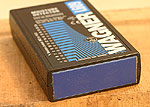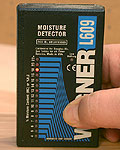This is a Veteran Owned site

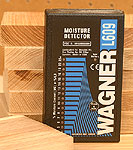 |
The Wagner L609 proved to be far more useful in the shop that I thought! Click image to enlarge |
Wagner L609 Moisture Meter
What’s wet and what ain’t
Text & Photos by Tom Hintz
Not knowing the moisture content in the wood we use can ruin an otherwise nice bit of woodworking. Anything from splits to failed glue joints or warped panels can result from the wood having a higher moisture content than we thought. The problem is that simply feeling the wood is not good enough. Its what’s inside that counts.
Easy to Use
Using the Wagner L609 is as easy as pushing a button - literally. Because it is a pinless moisture meter, all you do is hold its contact pad flat on the surface of the wood and press the button to take to take a reading. One of the 16 labeled LED’s on the face lights up to indicate the amount of moisture in that piece of wood.
There are a few things that can compromise accuracy. Moisture on the surface of the wood is a no-brainer. Other things like knots or heavy figuring of the wood can mean increased density that may skew the reading somewhat. Checking each piece of wood in several spots is a fast, easy way to get a real-world moisture indication.
Useable Range
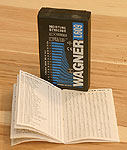 |
The included booklet includes conversion tables for a huge range of wood species. Click image to enlarge |
The Wagner L609 has a range from 4 to 22%, which while considered a narrow band is actually more than we need for woodworking. For most woodworking uses we are looking for a moisture content between 5 and 15% though that range can be expanded slightly by individual preference. If the Wagner L609 tells me a piece of wood has a moisture content of 20% (or more) and I want to use the wood this year, I’m no longer interested in it anyway.
A compromise common to mid-priced moisture meters is having to use a conversion chart to correct the reading for specific wood species. This sounds far more complicated than it is. After using the Wagner L609 for a while, I found that converting the reading is simple and frequently not necessary. We will discuss that point in more detail later In The Shop.
A pocket-sized booklet is included with the Wagner L609 that includes conversion charts that cover a large number of wood species. Since most woodworkers have a favorite group of woods they use most, learning the amount of correction that must be applied (often 2 or 3%) quickly becomes second nature.
In The Shop
 |
I anticipated using the Wagner L609 primarily for checking turning blanks but found it far more useful in the shop. Click image to enlarge |
Though I anticipated using the Wagner L609 primarily for checking the progress of turning stock as it dries, general shop use was also a factor. After having the Wagner L609 in the shop for a while now, I find myself using it more frequently for checking board stock than turning materials. Being able to accurately determine the moisture content of the wood I use has been an enlightening experience.
Checking the moisture content of wood when buying it is a common use but just as important is matching pieces of wood for glue ups. Using individual pieces of wood with similar moisture content levels when gluing up a panel helps reduce warping that can be caused by some pieces drying more than others.
Checking pieces of a glue up is one place where I seldom refer to the correction charts. I am most interested in similar moisture contents among the pieces. As long as their levels are within a few percent of each other and that common number is within the target 6 to 10% range, I can be confident of producing the most stable panel possible with them.
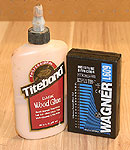 |
The Wagner L609 is invaluable for matching pieces of wood with similar moisture content for glue ups. Click image to enlarge |
Knowing the moisture content of wood can be important to using glue also. Most glues seem to work best with a moisture content of 5 to 10% though polyurethane adhesives actually like a bit more, up to 15% at the joint. Knowing how much moisture is in the wood to start with helps determine if adding more to the joint is necessary for the glue to work properly.
I have even found the Wagner L609 useful in determining which end of a board to cut parts from. Because most lumber is stacked in piles, sometimes outdoors, one end can be substantially wetter than the other. Being able to check that accurately (your fingers are not accurate) as well as seeing how far down the board that elevated moisture content runs, makes it easier to cut parts that will not distort excessively after they are cut or assembled into a project.
Wagner says that the L609 reads about ½”-deep in most woods. That is plenty for most board stock but can mean checking a thick piece of turning stock as it is reduced. I have found supposedly dry bowl blanks that went from around 10% at the surface to over 20% an inch or two inside. Here again, knowing that gives me the chance to bag the piece or apply a wax emulsion to let it dry further. Without the Wagner L609 I would have turned the piece and wound up with a cracked or warped project.
Conclusions
Pricing Link (new versions) |
With a street price of $169.99 (6-1-2006), the Wagner L609 is admittedly an investment to be considered. However, if the increased confidence in glue ups and the savings incurred by being able to pick the best wood for the job are considered, the value of the Wagner L609 becomes more evident.
The Wagner L609 can be an important addition to any woodworking shop whether you are new to the hobby or a veteran. You don’t have to be using exotic woods to need one either. In fact, new woodworkers that find themselves digging through piles of lower priced woods can be most susceptible to moisture related problems in their projects. The Wagner L609 can make choosing the best wood in the pile a much easier task and one that will improve your projects and the process of building them.
Visit the Wagner web site! - Click Here
Have a comment on this review? - Email Me!
All written, photographic and drawn materials are property of and copyright by NewWoodworker.com LLC 2000-2019. Materials may not be used in any way without the written permission of the owner.

